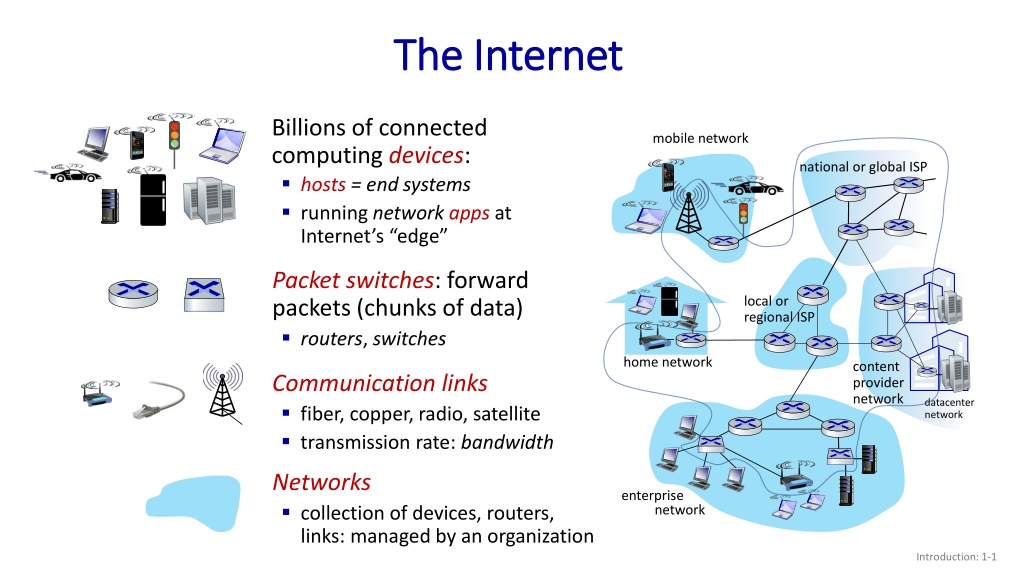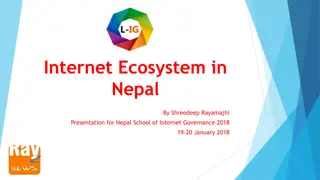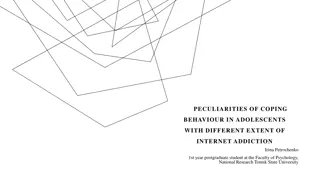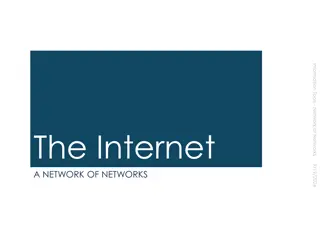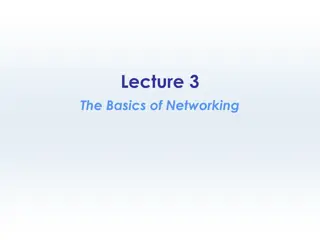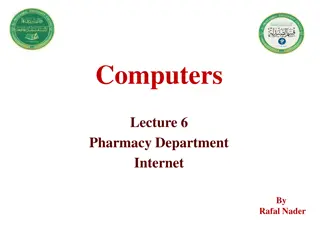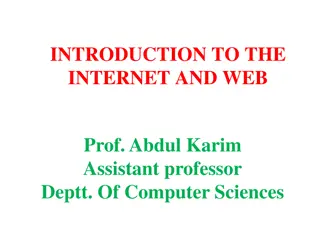Understanding the Basics of the Internet and Network Structure
Billions of connected computing devices make up the Internet, with hosts, packet switches, routers, and communication links facilitating data transmission. The Internet functions as a network of networks, enabling various services like web browsing, video streaming, and online communication. Different views, including the nuts and bolts perspective and services provision, help understand the complexity and organization of networks through protocol layers and reference models.
Uploaded on Nov 16, 2024 | 0 Views
Download Presentation

Please find below an Image/Link to download the presentation.
The content on the website is provided AS IS for your information and personal use only. It may not be sold, licensed, or shared on other websites without obtaining consent from the author. Download presentation by click this link. If you encounter any issues during the download, it is possible that the publisher has removed the file from their server.
E N D
Presentation Transcript
The Internet The Internet Billions of connected computing devices: hosts = end systems running network apps at Internet s edge mobile network national or global ISP Packet switches: forward packets (chunks of data) routers, switches local or Internet regional ISP home network content provider network Communication links fiber, copper, radio, satellite transmission rate: bandwidth datacenter network Networks collection of devices, routers, links: managed by an organization enterprise network Introduction: 1-1
The Internet: a nuts and bolts view The Internet: a nuts and bolts view mobile network 4G Internet: network of networks Interconnected ISPs national or global ISP protocols are everywhere control sending, receiving of messages e.g., HTTP (Web), streaming video, Skype, TCP, IP, WiFi, 4G, Ethernet Streaming video IP Skype local or regional ISP home network content provider network HTTP datacenter network Internet standards IEEE IETF: Internet Engineering Task Force Ethernet TCP enterprise network WiFi Introduction: 1-2
The Internet: a services view The Internet: a services view Infrastructure that provides services to applications: Web, streaming video, multimedia teleconferencing, email, games, e- commerce, social media, inter- connected appliances, provides programming interface to distributed applications: hooks allowing sending/receiving apps to connect to, use Internet transport service provides service options, analogous to postal service mobile network national or global ISP Streaming video Skype local or regional ISP home network content provider network HTTP datacenter network enterprise network Introduction: 1-3
Protocol l Protocol layers and reference models ayers and reference models Networks are complex, with many pieces : hosts routers links of various media applications protocols hardware, software Question:is there any hope of organizing structure of network? and/or our discussion of networks? Introduction: 1-4
Why layering? Why layering? Approach to designing/discussing complex systems: explicit structure allows identification, relationship of system s pieces layered reference model for discussion modularization eases maintenance, updating of system change in layer's service implementation: transparent to rest of system e.g., change in gate procedure doesn t affect rest of system Introduction: 1-5
Layered Internet protocol stack Layered Internet protocol stack application:supporting network applications HTTP, IMAP, SMTP, DNS transport:process-process data transfer TCP, UDP network:routing of datagrams from source to destination IP, routing protocols link:data transfer between neighboring network elements Ethernet, 802.11 (WiFi), PPP physical:bits on the wire application application transport transport network network link link physical physical Introduction: 1-6
Services, Layering and Encapsulation Services, Layering and Encapsulation M application application Application exchanges messages to implement some application service using services of transport layer Ht M transport transport Transport-layer protocol transfers M (e.g., reliably) from one process to another, using services of network layer network network transport-layer protocol encapsulates application-layer message, M, with transport layer-layer header Ht to create a transport-layer segment Ht used by transport layer protocol to implement its service link link physical physical destination source Introduction: 1-7
Services, Layering and Encapsulation Services, Layering and Encapsulation M application application Ht M transport transport Transport-layer protocol transfers M (e.g., reliably) from one process to another, using services of network layer network network Hn Ht M Network-layer protocol transfers transport-layer segment [Ht | M] from one host to another, using link layer services link link network-layer protocol encapsulates transport-layer segment [Ht | M] with network layer-layer header Hn to create a network-layer datagram Hn used by network layer protocol to implement its service physical physical destination source Introduction: 1-8
Services, Layering and Encapsulation Services, Layering and Encapsulation M application application Ht M transport transport network network Hn Ht M Network-layer protocol transfers transport-layer segment [Ht | M] from one host to another, using link layer services link link Hn Ht Hl M Link-layer protocol transfers datagram [Hn| [Ht |M] from host to neighboring host, using network-layer services physical physical link-layer protocol encapsulates network datagram [Hn| [Ht |M], with link-layer header Hl to create a link-layer frame destination source Introduction: 1-9
Services, Layering and Encapsulation Services, Layering and Encapsulation M application application M message Ht M transport transport Ht M segment network network Hn Ht Hn Ht M M datagram Hn Ht Hl M link link Hn Ht Hl M frame physical physical destination source Introduction: 1-10
source Encapsulation: an Encapsulation: an end end- -end view end view message application transport network link physical M segment Ht Ht M datagram frame Hn Hn Ht Ht Hn M M Hl link physical switch destination network link physical Hn Ht M Hl Hn Ht M application transport network link physical Hn Ht M M Ht M Hn Ht M router Hl Hn Ht M Introduction: 1-11
ISO/OSI reference model ISO/OSI reference model Two layers not found in Internet protocol stack! presentation: allow applications to interpret meaning of data, e.g., encryption, compression, machine-specific conventions session: synchronization, checkpointing, recovery of data exchange Internet stack missing these layers! these services, if needed, must be implemented in application needed? application presentation session transport network link physical The seven layer OSI/ISO reference model Introduction: 1-12
Data Link Layer Data Link Layer The data link layer is an interface between the network and physical layer. The Data Link layer is responsible for organizing the bit-level data for communication between devices on a network and detecting and correcting Physical layer errors. also it is responsible for the multiplexing of data streams and data frame detection It is further subdivided into two modules: Medium Access Control (MAC) plays a critical role in conserving network life by efficiently allocating medium access to the contending nodes. Logical Link Control (LLC) is on top of the MAC layer and is responsible for cyclic redundancy check (CRC), sequencing information, and addition of appropriate source and destination information. Introduction: 1-14
LLC LLC LLC layer lets the upper layers communicate with any form of transmission media in the same way. Flow Control, it control the rate of data transmission between two sources and destination hosts Error detection and correction LLC layer protocols include specifications for the frames of many types of physical networks, including Ethernet, WIFI, FDDI (Fiber Distributed Data Interface). Introduction: 1-15
MAC MAC It maintains, and manages the communications between the access points (AP) and the 802.11 clients. Coordinate the access to the shared radio channel for all the devices Introduction: 1-16
The Physical Layer The Physical Layer Physical Layer Convergence Protocol(PLCP): frame exchange between the MAC and PHY, used to indicate data rates and packet length. Physical Medium Dependent(PMD): uses signal carrier and modulation to transmit data frames over the media. This service interfaces directly to the RF. It modulates/demodulates (MODEM) the frame transmissions. Direct Sequence Spread Spectrum (DSSS) PHY The Frequency Hopping Spread Spectrum (FHSS) PHY Infrared (IR) PHY
